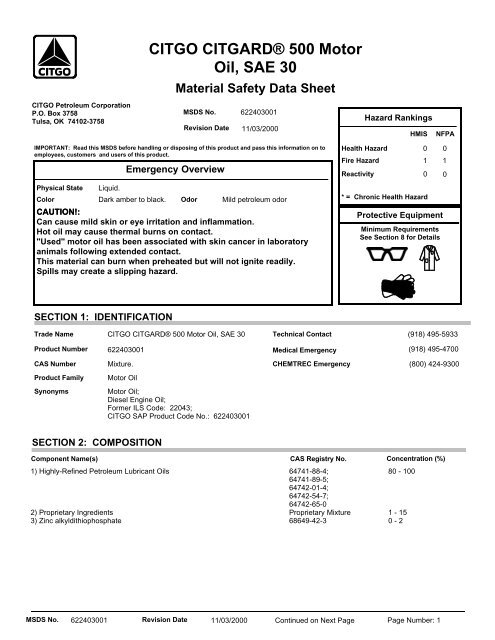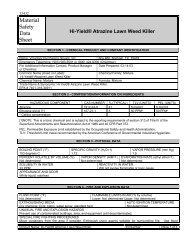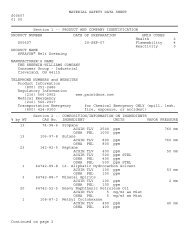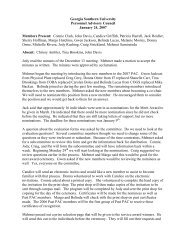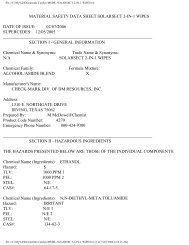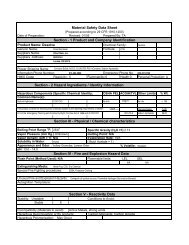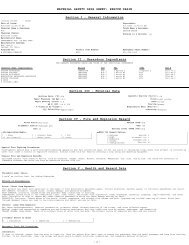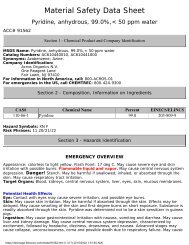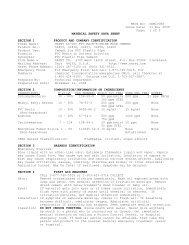CITGO CITGARD 500 Motor Oil, SAE 30 (English) CITGO ... - services
CITGO CITGARD 500 Motor Oil, SAE 30 (English) CITGO ... - services
CITGO CITGARD 500 Motor Oil, SAE 30 (English) CITGO ... - services
Create successful ePaper yourself
Turn your PDF publications into a flip-book with our unique Google optimized e-Paper software.
<strong>CITGO</strong> Petroleum Corporation<br />
P.O. Box 3758<br />
Tulsa, OK 74102-3758<br />
<strong>CITGO</strong> <strong>CITGARD</strong>® <strong>500</strong> <strong>Motor</strong><br />
<strong>Oil</strong>, <strong>SAE</strong> <strong>30</strong><br />
Material Safety Data Sheet<br />
MSDS No.<br />
62240<strong>30</strong>01<br />
Revision Date 11/03/2000<br />
Hazard Rankings<br />
HMIS<br />
NFPA<br />
IMPORTANT: Read this MSDS before handling or disposing of this product and pass this information on to<br />
employees, customers and users of this product.<br />
Physical State<br />
Color<br />
Liquid.<br />
Emergency Overview<br />
Dark amber to black. Odor Mild petroleum odor<br />
CAUTION!:<br />
Can cause mild skin or eye irritation and inflammation.<br />
Hot oil may cause thermal burns on contact.<br />
"Used" motor oil has been associated with skin cancer in laboratory<br />
animals following extended contact.<br />
This material can burn when preheated but will not ignite readily.<br />
Spills may create a slipping hazard.<br />
Health Hazard<br />
Fire Hazard<br />
Reactivity<br />
* = Chronic Health Hazard<br />
Protective Equipment<br />
Minimum Requirements<br />
See Section 8 for Details<br />
0<br />
1<br />
0<br />
0<br />
1<br />
0<br />
SECTION 1: IDENTIFICATION<br />
Trade Name<br />
<strong>CITGO</strong> <strong>CITGARD</strong>® <strong>500</strong> <strong>Motor</strong> <strong>Oil</strong>, <strong>SAE</strong> <strong>30</strong><br />
Technical Contact<br />
(918) 495-5933<br />
Product Number<br />
CAS Number<br />
Product Family<br />
Synonyms<br />
62240<strong>30</strong>01<br />
Mixture.<br />
<strong>Motor</strong> <strong>Oil</strong><br />
<strong>Motor</strong> <strong>Oil</strong>;<br />
Diesel Engine <strong>Oil</strong>;<br />
Former ILS Code: 22043;<br />
<strong>CITGO</strong> SAP Product Code No.: 62240<strong>30</strong>01<br />
Medical Emergency<br />
(918) 495-4700<br />
CHEMTREC Emergency (800) 424-9<strong>30</strong>0<br />
SECTION 2: COMPOSITION<br />
Component Name(s)<br />
CAS Registry No. Concentration (%)<br />
1) Highly-Refined Petroleum Lubricant <strong>Oil</strong>s 64741-88-4;<br />
80 - 100<br />
64741-89-5;<br />
64742-01-4;<br />
64742-54-7;<br />
64742-65-0<br />
2) Proprietary Ingredients Proprietary Mixture 1 - 15<br />
3) Zinc alkyldithiophosphate 68649-42-3 0 - 2<br />
MSDS No. 62240<strong>30</strong>01 Revision Date 11/03/2000<br />
Continued on Next Page Page Number: 1
<strong>CITGO</strong> <strong>CITGARD</strong>® <strong>500</strong> <strong>Motor</strong> <strong>Oil</strong>, <strong>SAE</strong> <strong>30</strong><br />
SECTION 3: HAZARDS IDENTIFICATION<br />
Also see Emergency Overview and Hazard Ratings on the top of Page 1 of this MSDS.<br />
Major Route(s) of Entry Skin contact.<br />
Signs and Symptoms of Acute Exposure<br />
Inhalation<br />
Eye Contact<br />
Skin Contact<br />
Ingestion<br />
Chronic Health Effects<br />
Summary<br />
Conditions Aggravated<br />
by Exposure<br />
Target Organs<br />
Carcinogenic Potential<br />
No significant adverse health effects are expected to occur upon short-term exposure to this product.<br />
Aspiration of liquid into the lungs can cause severe lung damage or death.<br />
This product can cause transient mild eye irritation with short-term contact with liquid sprays or mists.<br />
This product can cause mild, transient skin irritation with short-term exposure.<br />
If swallowed, no significant adverse health effects are anticipated. Ingestion can cause a laxative effect. If<br />
aspirated into the lungs, liquid can cause severe lung damage or death.<br />
Contains a petroleum-based mineral oil. Prolonged or repeated skin contact can cause mild irritation and<br />
inflammation characterized by drying, cracking, (dermatitis) or oil acne. Repeated or prolonged inhalation<br />
of petroleum-based mineral oil mists at concentrations above applicable workplace exposure levels can<br />
cause respiratory irritation or other pulmonary effects.<br />
Personnel with pre-existing skin disorders should avoid repeated or prolonged contact with this product.<br />
Skin.<br />
This product does not contain any components at concentrations above 0.1% which are considered<br />
carcinogenic by OSHA, IARC, or NTP.<br />
OSHA Hazard Classification is indicated by an "X" in the box adjacent to the hazard title. If no "X" is present, the product does not exhibit the<br />
hazard as defined in the OSHA Hazard Communication Standard (29 CFR 1910.1200).<br />
OSHA Health Hazard Classification<br />
OSHA Physical Hazard Classification<br />
Irritant<br />
Toxic<br />
Combustible<br />
Explosive<br />
Pyrophoric<br />
Sensitizer<br />
Highly Toxic<br />
Flammable<br />
Oxidizer<br />
Water-reactive<br />
Corrosive<br />
Carcinogenic<br />
Compressed Gas<br />
Organic Peroxide<br />
Unstable<br />
SECTION 4: FIRST AID MEASURES<br />
Take proper precautions to ensure your own health and safety before attempting rescue or providing first aid. For more specific<br />
information, refer to Exposure Controls and Personal Protection in Section 8 of this MSDS.<br />
Inhalation<br />
Eye Contact<br />
Skin Contact<br />
Ingestion<br />
Vaporization is not expected at ambient temperatures. This material is not expected to cause<br />
inhalation-related disorders under anticipated conditions of use. In case of overexposure, move the<br />
person to fresh air.<br />
Check for and remove contact lenses. Flush eyes with cool, clean, low-pressure water while<br />
occasionally lifting and lowering eyelids. Seek medical attention if excessive tearing, redness, or pain<br />
persists.<br />
Remove contaminated shoes and clothing. Wipe off excess material. Wash exposed skin with soap<br />
and water. Seek medical attention if tissue appears damaged or if irritation persists. Thoroughly clean<br />
contaminated clothing before reuse. Discard contaminated leather goods. If material is injected under<br />
the skin, into muscle, or into the bloodstream, seek medical attention immediately.<br />
Do not induce vomiting unless directed to by a physician. Do not give anything to drink unless directed<br />
to by a physician. Never give anything by mouth to a person who is not fully conscious. Seek medical<br />
attention immediately.<br />
MSDS No. 62240<strong>30</strong>01 Revision Date 11/03/2000<br />
Continued on Next Page Page Number: 2
<strong>CITGO</strong> <strong>CITGARD</strong>® <strong>500</strong> <strong>Motor</strong> <strong>Oil</strong>, <strong>SAE</strong> <strong>30</strong><br />
Notes to Physician<br />
The viscosity range of the product(s) represented by this MSDS is greater than 400 SUS at 100°F.<br />
Accordingly, upon ingestion there is a low risk of aspiration. Careful gastric lavage or emesis may be<br />
considered to evacuate large quantities of material. Subcutaneous or intramuscular injection requires<br />
prompt surgical debridement.<br />
SECTION 5: FIRE FIGHTING MEASURES<br />
NFPA Flammability<br />
Classification<br />
Flash Point Method<br />
Lower Flammable Limit<br />
Autoignition Temperature<br />
Hazardous<br />
Combustion Products<br />
Special Properties<br />
Extinguishing Media<br />
Fire Fighting Protective<br />
Clothing<br />
NFPA Class-IIIB combustible material. Slightly combustible!<br />
CLOSED CUP: 212°C (414°F). (Pensky-Martens (ASTM D-93)) OPEN CUP: 263°C (505°F)<br />
(Cleveland.).<br />
No data.<br />
Not available.<br />
Upper Flammable Limit<br />
Carbon dioxide, carbon monoxide, smoke, fumes, unburned hydrocarbons and trace oxides of sulfur,<br />
phosphorus, zinc and nitrogen. Also, depending upon the conditions of use, low concentrations of<br />
hydrogen sulfide can be released.<br />
This material can burn but will not readily ignite. This material will release vapors when heated above<br />
the flash point temperature that can ignite when exposed to a source of ignition. In enclosed spaces,<br />
heated vapor can ignite with explosive force. Mists or sprays may burn at temperatures below the flash<br />
point.<br />
Use dry chemical, foam, Carbon Dioxide or water fog.<br />
No data.<br />
Firefighters must use full bunker gear including NIOSH-approved positive pressure self-contained<br />
breathing apparatus to protect against potential hazardous combustion or decomposition products and<br />
oxygen deficiencies.<br />
SECTION 6: ACCIDENTAL RELEASE MEASURES<br />
Take proper precautions to ensure your own health and safety before attempting spill control or clean-up. For more specific<br />
information, refer to the Emergency Overview on Page 1, Exposure Controls and Personal Protection in Section 8 and Disposal<br />
Considerations in Section 13 of this MSDS.<br />
Do not touch damaged containers or spilled material unless wearing appropriate protective equipment.<br />
Slipping hazard; do not walk through spilled material. Stop leak if you can do so without risk. For small<br />
spills, absorb or cover with dry earth, sand, or other inert non-combustible absorbent material and place<br />
into waste containers for later disposal. Contain large spills to maximize product recovery or disposal.<br />
Prevent entry into waterways or sewers. In urban area, cleanup spill as soon as possible. In natural<br />
environments, seek cleanup advice from specialists to minimize physical habitat damage. This material<br />
will float on water. Absorbent pads and similar materials can be used. Comply with all laws and<br />
regulations.<br />
SECTION 7: HANDLING AND STORAGE<br />
Handling<br />
Storage<br />
Avoid water contamination and extreme temperatures to minimize product degradation. Empty<br />
containers may contain product residues that can ignite with explosive force. Do not pressurize, cut,<br />
weld, braze solder, drill, grind or expose containers to flames, sparks, heat or other potential ignition<br />
sources. Consult appropriate federal, state and local authorities before reusing, reconditioning,<br />
reclaiming, recycling or disposing of empty containers and/or waste residues of this product.<br />
Keep container closed. Do not store with strong oxidizing agents. Do not store at temperatures above<br />
120° F or in direct sunlight for extended periods of time. Consult appropriate federal, state and local<br />
authorities before reusing, reconditioning, reclaiming, recycling or disposing of empty containers or waste<br />
residues of this product.<br />
MSDS No. 62240<strong>30</strong>01 Revision Date 11/03/2000<br />
Continued on Next Page Page Number: 3
<strong>CITGO</strong> <strong>CITGARD</strong>® <strong>500</strong> <strong>Motor</strong> <strong>Oil</strong>, <strong>SAE</strong> <strong>30</strong><br />
SECTION 8: EXPOSURE CONTROLS AND PERSONAL PROTECTION<br />
Engineering Controls<br />
Personal Protective<br />
Equipment<br />
Provide exhaust ventilation or other engineering controls to keep the airborne concentrations of mists<br />
and/or vapors below the recommended exposure limits (see below). An eye wash station and safety<br />
shower should be located near the work-station.<br />
Personal protective equipment should be selected based upon the conditions under which this material is<br />
used. A hazard assessment of the work area for PPE requirements should be conducted by a qualified<br />
professional pursuant to OSHA regulations. The following pictograms represent the minimum<br />
requirements for personal protective equipment. For certain operations, additional PPE may be required.<br />
Eye Protection<br />
Hand Protection<br />
Body Protection<br />
Respiratory Protection<br />
General Comments<br />
Safety glasses equipped with side shields should be adequate protection under most conditions of use.<br />
Wear goggles and/or face shield if splashing or spraying is anticipated. Wear goggles and face shield if<br />
material is heated above 125°F (51°C). Have suitable eye wash water available.<br />
Use gloves constructed of chemical resistant materials such as neoprene or heavy nitrile rubber if<br />
frequent or prolonged contact is expected. Use heat-protective gloves when handling product at<br />
elevated temperatures.<br />
Avoid prolonged and/or repeated skin contact. Use clean and impervious protective clothing (e.g.,<br />
neoprene or Tyvek ® ) if splashing or spraying conditions are present. Protective clothing should include<br />
long-sleeves, apron, boots and additional facial protection. Remove oil contaminated clothing.<br />
Launder oil contaminated clothing before reusing. Contaminated leather goods should be removed<br />
promptly and discarded.<br />
Vaporization or misting is not expected at ambient temperatures. Therefore, the need for respiratory<br />
protection is not anticipated under normal use conditions and with adequate ventilation. If elevated<br />
airborne concentrations above applicable workplace exposure levels are anticipated, a<br />
NIOSH-approved organic vapor respirator equipped with a dust/mist prefilter should be used.<br />
Protection factors vary depending upon the type of respirator used. Respirators should be used in<br />
accordance with OSHA requirements (29 CFR 1910.134).<br />
Use good personal hygiene practices. Wash hands and other exposed skin areas with plenty of mild<br />
soap and water before eating, drinking, smoking, use of toilet facilities, or leaving work. DO NOT use<br />
gasoline, kerosene, solvents or harsh abrasives as skin cleaners. Since specific exposure<br />
standards/control limits have not been established for this product, the "<strong>Oil</strong> Mist, Mineral" exposure<br />
limits shown below are suggested as minimum control guidelines.<br />
Occupational Exposure Guidelines<br />
Substance<br />
Applicable Workplace Exposure Levels<br />
1) Highly-Refined Petroleum Lubricant <strong>Oil</strong>s TWA: 5 STEL: 10 (mg/M 3 ) from ACGIH (TLV)<br />
TWA: 5 (mg/M 3 ) from OSHA (PEL)<br />
TWA: 5 STEL: 10 (mg/M 3 ) from NIOSH<br />
SECTION 9: PHYSICAL AND CHEMICAL PROPERTIES<br />
Physical State Liquid. Color Dark amber to black. Odor Mild petroleum odor<br />
Specific Gravity<br />
0.89 (Water = 1) pH Not Applicable. Vapor Density >1 (Air = 1)<br />
Boiling Point/Range<br />
Not available.<br />
Melting/Freezing Point<br />
Not available.<br />
Vapor Pressure<br />
<strong>CITGO</strong> <strong>CITGARD</strong>® <strong>500</strong> <strong>Motor</strong> <strong>Oil</strong>, <strong>SAE</strong> <strong>30</strong><br />
SECTION 10: STABILITY AND REACTIVITY<br />
Chemical Stability Stable.<br />
Hazardous Polymerization<br />
Not expected to occur.<br />
Conditions to Avoid<br />
Materials Incompatibility<br />
Hazardous<br />
Decomposition Products<br />
Keep away from extreme heat, sparks, open flame, and strongly oxidizing conditions.<br />
Strong oxidizers.<br />
No additional hazardous decomposition products were identified other than the combustion products<br />
identified in Section 5 of this MSDS.<br />
SECTION 11: TOXICOLOGICAL INFORMATION<br />
For other health-related information, refer to the Emergency Overview on Page 1 and the Hazards Identification in Section 3 of this<br />
MSDS.<br />
Toxicity Data<br />
Highly-Refined Petroleum Lubricant <strong>Oil</strong>s:<br />
ORAL (LD50): Acute: ><strong>500</strong>0 mg/kg [Rat].<br />
DERMAL (LD50): Acute: >2000 mg/kg [Rabbit].<br />
Zinc alkyldithiophosphate:<br />
ORAL (LD50): Acute: ><strong>500</strong>0 mg/kg [Rabbit]. >2890 mg/kg [Rat].<br />
DERMAL (LD50): Acute: >10000 mg/kg [Rabbit].<br />
Highly-Refined Petroleum Lubricant <strong>Oil</strong>s:<br />
Mineral oil mists derived from highly refined oils are reported to have low acute and sub-acute toxicities<br />
in animals. Effects from single and short-term repeated exposures to high concentrations of mineral oil<br />
mists well above applicable workplace exposure levels include lung inflammatory reaction, lipoid<br />
granuloma formation and lipoid pneumonia. In acute and sub-acute studies involving exposures to<br />
lower concentrations of mineral oil mists at or near current work place exposure levels produced no<br />
significant toxicological effects. In long term studies (up to two years) no carcinogenic effects have<br />
been reported in any animal species tested.<br />
Zinc alkyldithiophosphate:<br />
INHALATION (LC50): Acute: > 1310 mg/L (Rat screen level)(4 hours).<br />
DRAIZE EYE:<br />
Acute: Moderate to severe eye irritant. (Rabbit).<br />
DRAIZE DERMAL: Acute: Mild to moderate skin irritant. (Rabbit).<br />
BUEHLER DERMAL: Acute: Non-sensitizing. (Guinea Pig).<br />
28-Day DERMAL: Sub-Chronic: Severe skin irritant. (Rabbit). Reported reduced food<br />
consumption resulting in weight loss and testicular atrophy.<br />
<strong>Motor</strong> <strong>Oil</strong>s:<br />
Used motor oil was associated with cancer in lifetime skin painting studies with laboratory animals.<br />
Avoid prolonged or repeated contact with used motor oil. Use of good hygiene practices will reduce the<br />
liklihood of potential health effects.<br />
SECTION 12: ECOLOGICAL INFORMATION<br />
Ecotoxicity<br />
Environmental Fate<br />
Analysis for ecological effects has not been conducted on this product. However, if spilled, this product<br />
and any contaminated soil or water may be harmful to human, animal, and aquatic life. Also, the<br />
coating action associated with petroleum and petroleum products can be harmful or fatal to aquatic life<br />
and waterfowl.<br />
An environmental fate analysis has not been conducted on this specific product. However, plants and<br />
animals may experience harmful or fatal effects when coated with petroleum-based products.<br />
Petroleum-based (mineral) lube oils will normally float on water. In stagnant or slow-flowing waterways,<br />
an oil layer can cover a large surface area. As a result, this oil layer might limit or eliminate natural<br />
atmospheric oxygen transport into the water. With time, if not removed, oxygen depletion in the<br />
waterway can result in a loss of marine life or create an anaerobic environment. This material contains<br />
phosphorus which is a controlled element for disposal in effluent waters in most sections of North<br />
America. Phosphorus is known to enhance the formation of algae. Severe algae growth can reduce<br />
oxygen content in the water possibly below levels necessary to support marine life.<br />
MSDS No. 62240<strong>30</strong>01 Revision Date 11/03/2000<br />
Continued on Next Page Page Number: 5
<strong>CITGO</strong> <strong>CITGARD</strong>® <strong>500</strong> <strong>Motor</strong> <strong>Oil</strong>, <strong>SAE</strong> <strong>30</strong><br />
SECTION 13: DISPOSAL CONSIDERATIONS<br />
Hazard characteristic and regulatory waste stream classification can change with product use. Accordingly, it is the responsibility<br />
of the user to determine the proper storage, transportation, treatment and/or disposal methodologies for spent materials and<br />
residues at the time of disposition.<br />
Conditions of use may cause this material to become a hazardous waste, as defined by Federal or<br />
State regulations. It is the responsibility of the user to determine if the material is a hazardous waste<br />
at the time of disposal. Transportation, treatment, storage and disposal of waste material must be<br />
conducted in accordance with RCRA regulations (see 40 CFR 260 through 40 CFR 271). State and/or<br />
local regulations may be more restrictive. Contact the RCRA/Superfund Hotline at (800) 424-9346 or<br />
your regional US EPA office for guidance concerning case specific disposal issues.<br />
SECTION 14: TRANSPORT INFORMATION<br />
DOT Status<br />
Proper Shipping Name<br />
Hazard Class<br />
Not a U.S. Department of Transportation regulated material.<br />
Petroleum <strong>Oil</strong>, N.O.I.B.N.<br />
Not a DOT controlled material (United States). Packing Group(s)<br />
UN/NA ID<br />
Not applicable.<br />
Not applicable.<br />
Reportable Quantity<br />
A Reportable Quantity (RQ) has not been established for any components of this material.<br />
Placards<br />
Emergency Response Guide<br />
No.<br />
HAZMAT STCC No.<br />
MARPOL III Status<br />
Not applicable.<br />
Not available.<br />
Not a DOT "Marine Pollutant"<br />
per 49 CFR 171.8.<br />
SECTION 15: REGULATORY INFORMATION<br />
TSCA Inventory<br />
SARA <strong>30</strong>2/<strong>30</strong>4<br />
SARA 311/312<br />
SARA 313<br />
CERCLA<br />
CWA<br />
California<br />
Proposition 65<br />
This product and/or its components are listed on the Toxic Substance Control Act (TSCA) inventory.<br />
The Superfund Amendments and Reauthorization Act of 1986 (SARA) Title III requires facilities subject<br />
to Subparts <strong>30</strong>2 and <strong>30</strong>4 to submit emergency planning and notification information based on Threshold<br />
Planning Quantities (TPQs) and Reportable Quantities (RQs) for "Extremely Hazardous Substances"<br />
listed in 40 CFR <strong>30</strong>2.4 and 40 CFR 355. No components were identified.<br />
The Superfund Amendments and Reauthorization Act of 1986 (SARA) Title III requires facilities subject<br />
to this subpart to submit aggregate information on chemicals by "Hazard Category" as defined in 40<br />
CFR 370.2. This material would be classified under the following hazard categories:<br />
No SARA 311/312 hazard categories identified.<br />
This product contains the following components in concentrations above de minimis levels that are<br />
listed as toxic chemicals in 40 CFR Part 372 pursuant to the requirements of Section 313 of SARA:<br />
Zinc and Zinc Compounds, Concentration: 0 - 2%<br />
The Comprehensive Environmental Response, Compensation, and Liability Act of 1980 (CERCLA)<br />
requires notification of the National Response Center concerning release of quantities of "hazardous<br />
substances" equal to or greater than the reportable quantities (RQ's) listed in 40 CFR <strong>30</strong>2.4. As defined<br />
by CERCLA, the term "hazardous substance" does not include petroleum, including crude oil or any<br />
fraction thereof which is not otherwise specifically designated in 40 CFR <strong>30</strong>2.4. Chemical substances<br />
present in this product or refinery stream that may be subject to this statute are: Zinc and Zinc<br />
Compounds, Concentration: 0 - 2%<br />
This material is classified as an oil under Section 311 of the Clean Water Act (CWA) and the <strong>Oil</strong><br />
Pollution Act of 1990 (OPA). Discharges or spills which produce a visible sheen on waters of the United<br />
States, their adjoining shorelines, or into conduits leading to surface waters must be reported to the<br />
EPA's National Response Center at (800) 424-8802.<br />
This product is not known to contain the any components for which the State of California has found to<br />
cause cancer, birth defects or other reproductive harm.<br />
MSDS No. 62240<strong>30</strong>01 Revision Date 11/03/2000<br />
Continued on Next Page Page Number: 6
<strong>CITGO</strong> <strong>CITGARD</strong>® <strong>500</strong> <strong>Motor</strong> <strong>Oil</strong>, <strong>SAE</strong> <strong>30</strong><br />
New Jersey<br />
Right-to-Know Label<br />
Additional Regulatory<br />
Remarks<br />
<strong>Motor</strong> <strong>Oil</strong><br />
No additional regulatory remarks.<br />
SECTION 16: OTHER INFORMATION<br />
Refer to the top of Page 1 for the HMIS and NFPA Hazard Ratings for this product.<br />
REVISION INFORMATION<br />
Version Number<br />
Revision Date<br />
Print Date<br />
2.1<br />
11/03/2000<br />
Printed on 11/03/2000.<br />
ABBREVIATIONS<br />
AP = Approximately EQ = Equal > = Greater Than < = Less Than NA = Not Applicable ND = No Data NE = Not<br />
Established<br />
ACGIH = American Conference of Governmental Industrial Hygienists AIHA = American Industrial Hygiene Association<br />
IARC = International Agency for Research on Cancer NTP = National Toxicology Program<br />
NIOSH = National Institute of Occupational Safety and Health OSHA = Occupational Safety and Health Administration<br />
NPCA = National Paint and Coating Manufacturers Association<br />
HMIS = Hazardous Materials Information System<br />
NFPA = National Fire Protection Association EPA = Environmental Protection Agency<br />
DISCLAIMER OF LIABILITY<br />
THE INFORMATION IN THIS MSDS WAS OBTAINED FROM SOURCES WHICH WE BELIEVE ARE RELIABLE. HOWEVER, THE<br />
INFORMATION IS PROVIDED WITHOUT ANY WARRANTY, EXPRESSED OR IMPLIED REGARDING ITS CORRECTNESS. SOME<br />
INFORMATION PRESENTED AND CONCLUSIONS DRAWN HEREIN ARE FROM SOURCES OTHER THAN DIRECT TEST DATA ON THE<br />
SUBSTANCE ITSELF. THIS MSDS WAS PREPARED AND IS TO BE USED ONLY FOR THIS PRODUCT. IF THE PRODUCT IS USED AS<br />
A COMPONENT IN ANOTHER PRODUCT, THIS MSDS INFORMATION MAY NOT BE APPLICABLE. USERS SHOULD MAKE THEIR<br />
OWN INVESTIGATIONS TO DETERMINE THE SUITABILITY OF THE INFORMATION OR PRODUCTS FOR THEIR PARTICULAR<br />
PURPOSE.<br />
THE CONDITIONS OR METHODS OF HANDLING, STORAGE, USE, AND DISPOSAL OF THE PRODUCT ARE BEYOND OUR CONTROL<br />
AND MAY BE BEYOND OUR KNOWLEDGE. FOR THIS AND OTHER REASONS, WE DO NOT ASSUME RESPONSIBILITY AND<br />
EXPRESSLY DISCLAIM LIABILITY FOR LOSS, DAMAGE OR EXPENSE ARISING OUT OF OR IN ANY WAY CONNECTED WITH<br />
HANDLING, STORAGE, USE OR DISPOSAL OF THE PRODUCT.<br />
* * * * * END OF MSDS * * * * *


